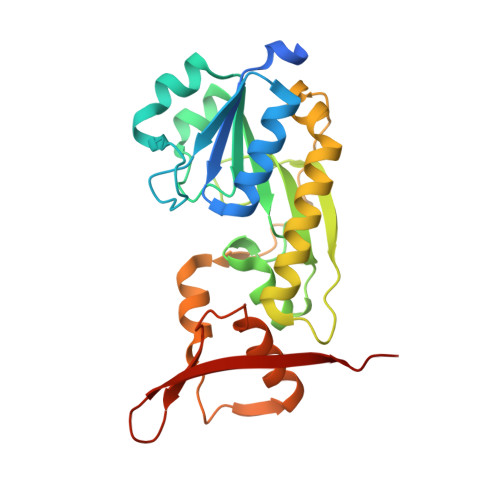Biochemical Investigation of Rv3404c from Mycobacterium tuberculosis.
Dunsirn, M.M., Thoden, J.B., Gilbert, M., Holden, H.M.(2017) Biochemistry 56: 3818-3825
- PubMed: 28665588
- DOI: https://doi.org/10.1021/acs.biochem.7b00506
- Primary Citation of Related Structures:
5VYQ - PubMed Abstract:
The causative agent of tuberculosis, Mycobacterium tuberculosis, is a bacterium with a complex cell wall and a complicated life cycle. The genome of M. tuberculosis contains well over 4000 genes thought to encode proteins. One of these codes for a putative enzyme referred to as Rv3404c, which has attracted research attention as a potential virulence factor for over 12 years. Here we demonstrate that Rv3404c functions as a sugar N-formyltransferase that converts dTDP-4-amino-4,6-dideoxyglucose into dTDP-4-formamido-4,6-dideoxyglucose using N 10 -formyltetrahydrofolate as the carbon source. Kinetic analyses demonstrate that Rv3404c displays a significant catalytic efficiency of 1.1 ¡Á 10 4 M -1 s -1 . In addition, we report the X-ray structure of a ternary complex of Rv3404c solved in the presence of N 5 -formyltetrahydrofolate and dTDP-4-amino-4,6-dideoxyglucose. The final model of Rv3404c was refined to an overall R-factor of 16.8% at 1.6 ? resolution. The results described herein are especially intriguing given that there have been no published reports of N-formylated sugars associated with M. tuberculosis. The data thus provide a new avenue of research into this fascinating, yet deadly, organism that apparently has been associated with human infection since ancient times.
Organizational Affiliation:
Department of Biochemistry, University of Wisconsin , Madison, Wisconsin 53706, United States.

























